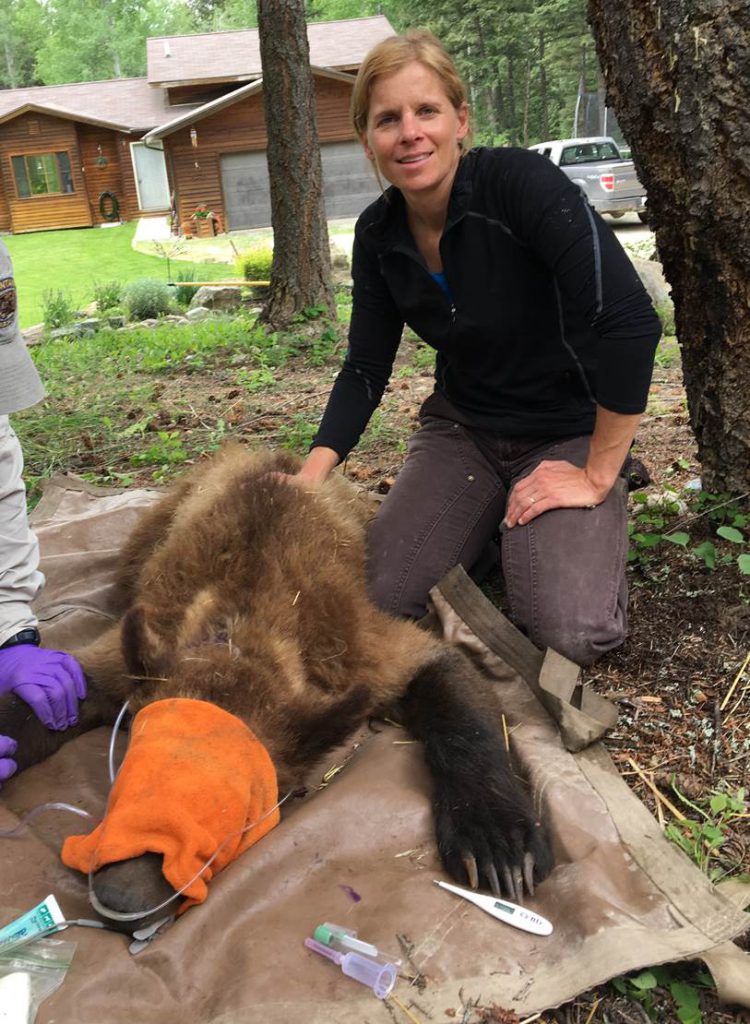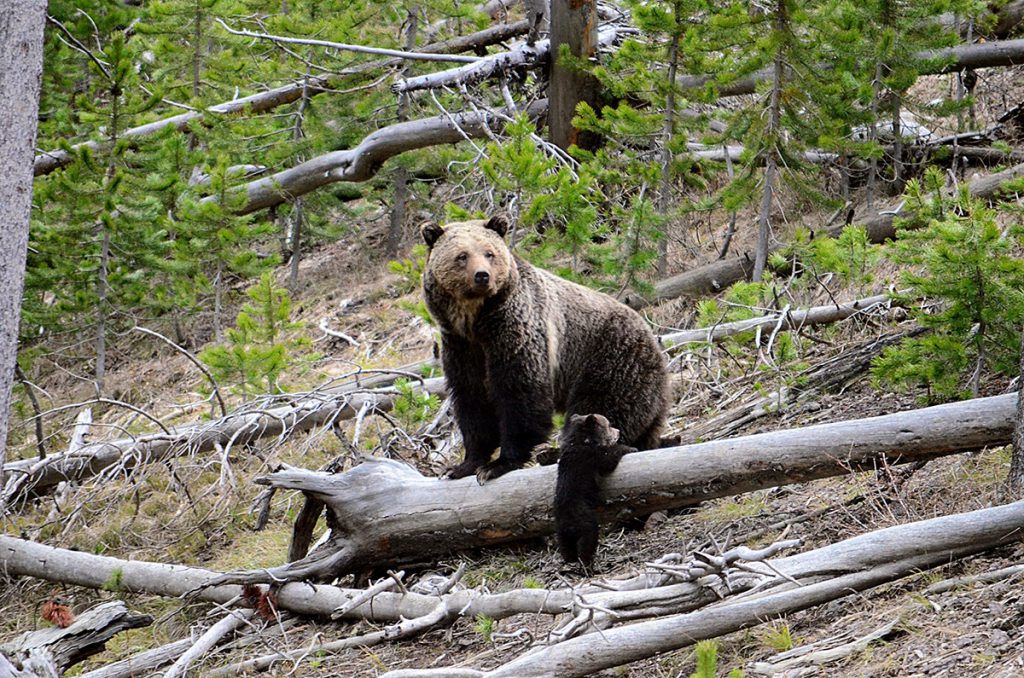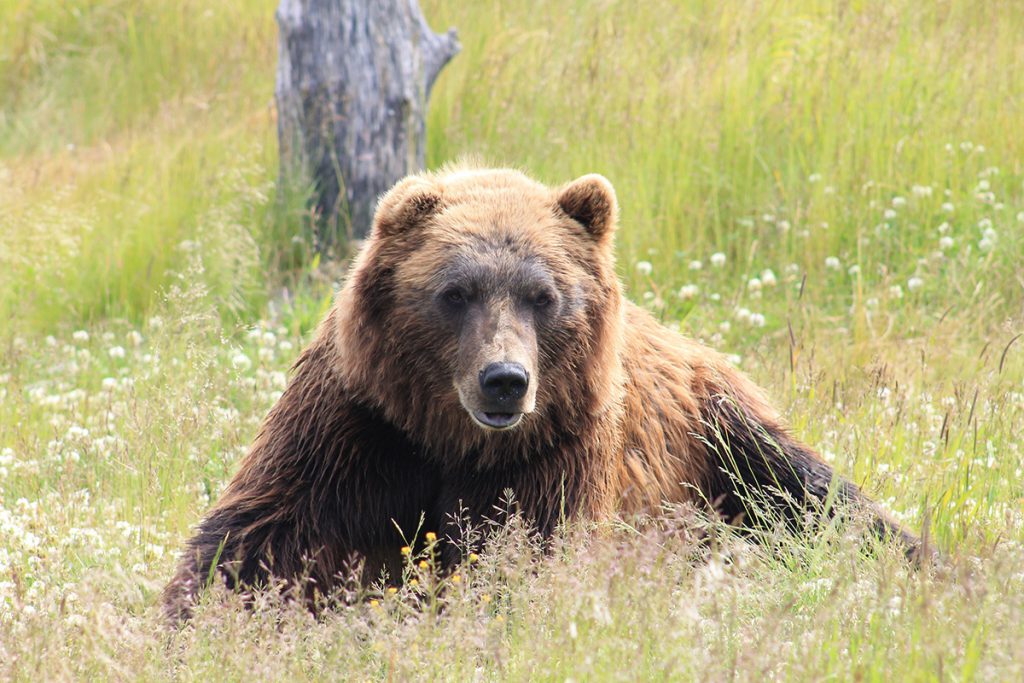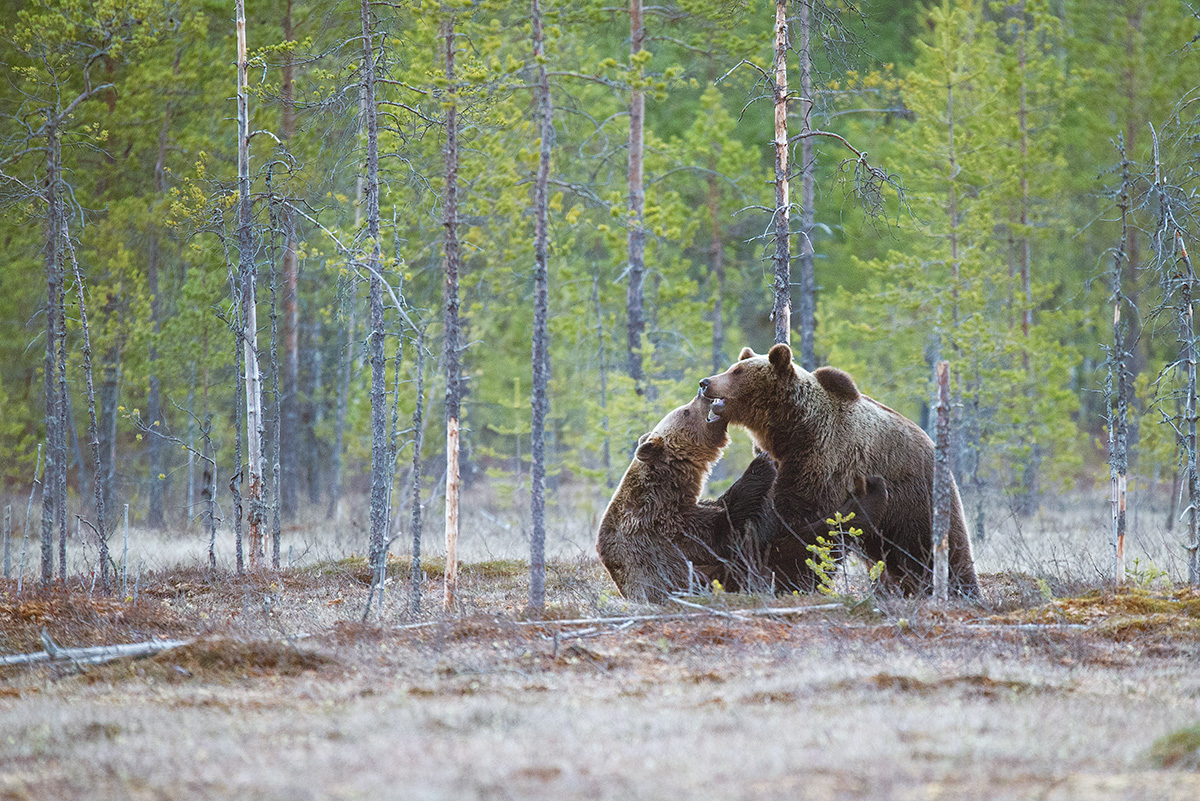This story was updated on Sept. 23, 2019.
In the early 1800s, an estimated 50,000 grizzly bears inhabited the land stretching from the Great Plains to the Pacific Ocean — terrain that, at that time, was largely unpopulated.
Hunted to the edge of extinction, grizzlies found refuge in the Endangered Species Act (ESA). Since being listed in 1975, some grizzly bear populations have experienced significant growth, with those in the Greater Yellowstone Ecosystem (GYE) restored to the point of delisting in 2017 — a feat led by the U.S. Fish and Wildlife Service (FWS) in conjunction with state wildlife agencies in Idaho, Wyoming and Montana.
This recovery, however, was not without its growing pains.
The American West, although still largely rural, is not the same unsettled territory it was when grizzlies dominated the landscape 200 years ago. Today, thousands of people live in and around GYE, along with a grizzly bear population that numbers in the 700s.

As their distribution expanded, FWS “interpreted that as the bear population inside the monitoring area had reached carrying capacity,” says Hilary Cooley, grizzly bear recovery coordinator for FWS.
“We have specific boundaries within which we monitor for practical reasons, and … over time, their population was increasing in there, and it leveled out,” she says. “But bears have expanded their distribution outside of these areas and will continue to do so.”
FWS’s decision to delist GYE grizzlies in 2017, however, was and remains controversial. Some have argued that a population of 700 is not sustainable and that climate change and other factors are contributing to the loss of key food sources for the bears — specifically, whitebark pine. This argument is one FWS has heard before.
“We had attempted to delist in 2007 — at that time, we thought the species was recovered — but we lost in litigation, mostly over … the whitebark pine; it produces pine nuts that are high in fat and pretty valuable to bears,” Cooley says. “There had been some big declines in those tree populations, especially in Yellowstone. But they produce pine nuts every other year, so bears were used to dealing with periods without them.
“They also have more than 200 food species that they eat, and we didn’t feel that — we didn’t have evidence, either — the loss of these pine trees was going to be a threat to bears.”
But with a ruling in favor of the plaintiffs, the GYE grizzly remained on the endangered species list. Further study of the whitebark pine and its effects on the population revealed that while the tree’s numbers had declined, Cooley says, “we didn’t see any negative population-wide effects to bears in that ecosystem that we can say are due to whitebark pine.”
FWS’s decision to delist the bear in 2017 was once again met with resistance as both Idaho and Wyoming decided to facilitate hunts in 2018, which would have allowed sportsmen to harvest up to 23 animals — one in Idaho and up to 22 in Wyoming; Montana decided not to host a hunt.
Grizzlies have been called “national treasures” and “icons”; sportsmen “trophy hunters”; and the hunt itself “inhumane,” “cruel” and “senseless.”
In reaction, some wildlife organizations and groups as well as individuals employed a variety of tactics to turn the tide of public opinion against the hunts. One movement, called “Shoot ’Em With a Camera,” encouraged wildlife photographers to apply for one of the available permits in order to keep them out of the hands of hunters.
In another effort, the Center for Biological Diversity posted a billboard that pictured a grizzly bear in the crosshairs of a rifle and read “I’m a Bear, Not a Trophy” — part of a larger campaign to garner petitions to restore the species to the endangered species list.
Further inflaming an already tense debate is the language oft used by opponents: Grizzlies have been called “national treasures” and “icons”; sportsmen “trophy hunters”; and the hunt itself “inhumane,” “cruel” and “senseless.” Yet the reality of the need to coexist with bears requires diligent management — a notion that some repudiate, particularly those who aren’t directly affected by the expanding population.
“We have to recognize that these predators do cause problems and, in some cases, bears actually kill people,” says Cooley. “The people who live in that ecosystem are experiencing the hardships that sometimes come with wolves or with bears, and so it’s a tough balance.”
“Management of bears is needed in human occupied areas,” she adds. “And whatever that management is, people will disagree or have different ideas of [how to handle] it. My job is to make sure that we have brought the species back to a recovered level as required under the ESA and then allow the states to manage it.”
But FWS’s decision to delist was once again challenged in the courts; one of the plaintiffs in the case was the Center for Biological Diversity. On August 30, 2018, two days before Wyoming’s first scheduled hunt, U.S. District Judge Dana Christensen granted a temporary restraining order to delay the hunt; he issued a second restraining order on Sept. 13, 2018, allowing him additional time to consider the case and make his final determination regarding whether the bears should be reinstated to the endangered species list.
While Christensen reportedly expressed a desire to hear out and understand both sides of the issue, according to Montana Public Radio, the Wyoming Game and Fish Department expressed disappointment at that time with his temporary ruling.
“Grizzly bears in the GYE have been above biological recovery goals since 2003, and Wyoming has a robust grizzly bear management program with strong regulations, protections and population monitoring for grizzly bears.”
“Grizzly bears in the GYE have been above biological recovery goals since 2003, and Wyoming has a robust grizzly bear management program with strong regulations, protections and population monitoring for grizzly bears,” Renny MacKay, communications director with the department, said in an email.
On Sept. 24, 2018, Christensen ruled in favor of environmental groups to reinstate federal ESA protections for the GYE grizzly bear — effectively blocking the hunts — stating that the bears still faced significant threats. He also argued that FWS erred when it attempted to delist one population without considering the recovery of other grizzly populations in the Lower 48.
This passed the buck back to FWS, which announced in December its decision to appeal Christensen’s ruling, which was followed by appeals from Idaho, Wyoming and Montana.
Further complicating matters, in February 2019, Montana introduced a joint resolution that would transfer management of all grizzly bears in Montana to the state and would block any court review of this action.
FWS officials have been critical of the move — which proposes creating a distinct population segment of grizzlies in the state — noting that the creation of six separate recovery zones was intentional and that the animal in each region is at varying levels of recovery.
___
Passed by Congress in 1973, the ESA “provide[s] a framework to conserve and protect endangered and threatened species and their habitats,” according to the FWS website. Created to focus on recovery, the act is not meant to provide indefinite protections.
“I think a lot of people forget or don’t realize that … when we delist, we’re not saying we don’t think there should be any more bears or they shouldn’t be in any more places,” says Cooley. “We’re saying we should delist because we’ve met what the ESA requires us to do — and it’s not to recover bears everywhere. That’s not our decision. We just get them out of the emergency room.”
In 1975, when grizzly bears were added to the endangered species list, small populations remained in six areas of the U.S.: Greater Yellowstone, Northern Continental Divide, Cabinet-Yaak, Selkirk, North Cascade and Bitterroot. It was in these regions that FWS decided to focus its recovery efforts.
In these zones, FWS established boundaries for what it refers to as demographic monitoring areas (DMAs). Larger than a recovery zone, Cooley says, these areas provide a buffer between “suitable habitat” for the bears and those that may not be so suitable (i.e., those with a high density of humans) as well as a consistent area in which to compare population size.
When a decision is made to evaluate a population for delisting — an action FWS can initiate itself or that another entity can petition the agency to do — there are a number of criteria that must be assessed.
“There are things like numbers of bears, distribution — we don’t want all the bears in one part of the ecosystem, … and we want reproducing females in a certain number of cells. Then there’s mortality limits, because human-caused mortality was one of the main reasons grizzly bears were listed in the first place,” Cooley says. “There is also habitat criteria. We quantify all of those things, and then we go through the list [to determine whether] they have met it or not.”

Another key consideration is threat assessment. This process includes examining factors such as habitat destruction or modification, predation (preying on other animals), disease, and regulatory mechanisms. “So is there any legally enforceable mechanism that can ensure that mortality will not rise to a certain level?” says Cooley.
“So [those are the] factors we go through [to discern the] current situation,” she adds, “is that still a threat to bears, has anything changed, what things do we have in place to make sure that won’t become a threat in the foreseeable future? If those all look good, that is what makes our decision. It is based on the best available science.”
In GYE, Cooley says a bear population in excess of 700 — an estimate she calls “conservative”; evidence of animals expanding beyond the DMA; and other factors prompted FWS to evaluate the species for delisting.
“[The population’s] been fairly stable for a number of years,” she says. “We had reproducing females within our distribution requirements. We had mortality levels controlled to the levels that we have identified in the recovery plan. So the population was just doing well, really well.”
As the 2017 GYE Final Rule points out, under the ESA, “species recovery is considered to be the return of a species to the point where it is no longer threatened or endangered.” Contrary to some perceptions of the ESA, “Recovery under the act does not require restoring a species to carrying capacity, historic levels, or even maximizing density, distribution, or genetic diversity.”
“Recovery under the [ESA] does not require restoring a species to carrying capacity, historic levels, or even maximizing density, distribution, or genetic diversity.”
Once a species is removed from the endangered species list, management is turned over to the states. However, according to Cooley, FWS continues to do post-monitoring for a minimum of five years, and in this case, she says the agency anticipates monitoring for a longer period of time as bears are “sensitive species.”
“We have to write a post-delisting monitoring plan, and usually we do that in cooperation with the state or whoever’s going to be doing most of the monitoring on the ground … to make sure that once a species is delisted, it remains recovered,” she says. “So it includes things like mortality limits, continuing to monitor those] and produce reports. We’ll take a close look at their hunting [regulations]. We review those and decide whether [or not] we think it is going to be a problem.
“There’s a whole suite of things the states are going to continue to monitor, and when those reports come out, we’ll evaluate them.”
Should they see a spike in mortalities, or one of a number of other criteria, FWS will step in. “We have some specific triggers that are in our delisting rule that say if this happens or if this threshold is met, we’ll do an automatic status review,” says Cooley.
While delisting removes certain protections for the bears and opens up the prospect of a hunt, Cooley says that many people seem to think that the handing over of management to the states means that “bears are just going to be shot left and right.”
“Bear are listed as game species, and that means they can only be taken with a permit with special regulations. It’s not a free for all,” she says. “The ESA protections go away, but the states do a great job of managing them. They want to maintain bears, too.”
___
The rise of the grizzly bear population in the last several decades has meant an increase in bear-human conflicts.
According to the book Yellowstone Grizzly Bears: Ecology and Conservation of an Icon of Wildness— published by Yellowstone Forever, the official nonprofit partner of Yellowstone National Park — from 2002 to 2014, there were 2,497 conflicts reported in GYE; this is an average of approximately 200 per year. More than three-quarters of these incidents included bears killing livestock or damaging property while obtaining human foods, and all conflicts were distributed evenly among public and private lands.
From 2002 to 2014, there were 2,497 bear-human conflicts reported in GYE.
“There are certain areas in the GYE that we have bears interacting with livestock, especially the Green River; we have a lot of livestock depredation there,” says Cooley, adding that in the worst cases, FWS may euthanize. “We have a special rule attached to the bear delisting that we can euthanize bears, given certain situations, if depredation is a continued problem.”
Although euthanizing is often a last resort, there is a specific procedure that must be followed when a producer is having an issue with a bear. In most cases, a staff biologist with a state’s wildlife agency would visit the site to determine whether the predator was a grizzly.
“They make a decision depending on a lot of things specific to that situation: has this guy had problems before, is this new, do we know anything about the bear involved? And they’ll go and try to trap it,” explains Cooley. “If it’s a first-time offense, sometimes they’ll just move the bear, or sometimes they can just harass the bear out of there, make him go away.”
To try to prevent these situations, FWS and state agencies also work with producers to eliminate any attractants on their property, such as grain or bone piles.
“We try and make sure that … even before people have problems, they clean up all of that so there are no attractants for bears,” Cooley says. “If the problem continues, then you trap the bear, and if this bear has depredated multiple, multiple times, the decision may be to euthanize it. It all just depends on the situation, and we really are judicious with euthanizing. Nobody likes to have to do that.”
Some have questioned whether relocation of problem bears is a viable solution. While this is a tactic Wyoming Game and Fish has used for decades, MacKay said they have “limited options for places to move bears” as they cannot relocate them to the national parks or the Wind River Reservation. However, there may be the potential to move them to other ecosystems or tribal lands. “These are potential options we would be open to after a thorough discussion with those groups and other potentially affected entities, who have not approached us,” he said, “and the relocation would need to be to suitable habitat.”
Others have expressed concern over human safety in and around Yellowstone National Park and Grand Teton National Park as the bear population grows. Most recently, in September 2019, three hunters were attacked by grizzlies in two separate incidents in Montana.
To manage the rise in population levels following FWS’ last attempt at delisting the species, Wyoming Game and Fish decided to open a hunt — a decision that followed a series of public meetings in and around GYE. “[We] traveled around the state to get the public’s opinions on the future of grizzly bear management, including hunting,” said MacKay. “The public told us that they supported hunting in Wyoming.”
“They’re not going to have a hunt that takes more bears than is sustainable for the population.”
Taking all public input into consideration, the department developed hunting regulations, which were available online for public review and comment for 53 days. Wyoming Game and Fish also hosted eight public meetings across the state to present the regulations and answer questions.
“We incorporated as much public comment as possible into the hunting regulations while maintaining the sideboards that are required for maintaining a recovered grizzly bear population,” MacKay said. “[We] worked with Idaho and Montana to determine that a hunt could go forward and bear numbers would remain above objectives. These discussions also occurred with representatives of the U.S. Forest Service, Yellowstone National Park, Grand Teton National Park and Wind River Reservation. After hunting regulations were finalized by the department, they were presented to our commission and approved in May of 2018.”
The state then issued licenses for seven designated areas. In six of these — those within the DMA — the state issued a combined total of 10 tags. “The total quota across all those areas is one female or 10 males,” MacKay said. “Only one hunter would be allowed out at a time, and so the hunt would stop when either one female is killed or 10 males.”
However, in area seven, which is outside of the DMA and thus is not considered suitable habitat for bears, Wyoming Game and Fish issued 12 licenses, allowing for the harvesting of up to 12 bears of any sex. “So the total would be a maximum of 22, and a minimum of 13 hunters who had licenses,” MacKay explained.
According to Cooley, the states “have agreed to look at all mortalities, [including] human caused, natural, accidental, management removals and … will limit those to a certain level depending on the population size.”
“They’re not going to have a hunt that takes more bears than is sustainable for the population,” she adds.

Wyoming Game and Fish considers regulated hunting not only a “pragmatic and cost-effective tool for managing populations at desired levels,” but it also “generates public support, ownership of the resource and funding for conservation,” according to the agency’s hunting plan.
For Cooley, the most important factor in grizzly bear deaths is not the causes but the bigger picture.
“People might have a problem with hunters taking bears. I understand that, but whether it is a hunt or a management removal or some other mortality, that’s not really the issue,” she says. “We have to limit mortalities period.”
“I don’t think we are going to know if it’s going to have any effect … until after the hunt,” Cooley adds. “This is a really emotionally charged issue, so I have to say, let’s look at it scientifically, and scientifically, we look at those mortalities no different from, say, management removals; we would allow those mortalities in certain situations for conflict bears.”
Some critics, however, argue that the decision to delist the GYE grizzly in the first place was in reaction to pressure from the oil, gas and timber industries — and the politicians they helped elect. In an article on thewildlifenews.com titled “Why Delisting of Grizzly Bears is Premature,” ecologist George Wuerthner says, “Without ESA listing, environmentally destructive practices will have fewer restrictions, hence greater profits at the expense of the bear and its habitat.”
Others have expressed dismay over what they claim would be the murder of an icon, while others say that the killing of grizzlies would lessen their enjoyment when visiting the area.
Furthermore, critics have argued that allowing a hunt could cause tourism in the area to take a hit; National Park Service data indicate that, in 2016, visitors to Yellowstone spent more than $500 million in the surrounding communities. Todd Mangelsen, a Wyoming-based nature photographer who won one of the hunting tags and plans to only shoot grizzlies with his camera, told NPR, “The public has the right to see bears, and the hunters do not have the right to take that away from the public.”
Others contend that hunters have done more for conservation than many other Americans. Even President Theodore Roosevelt, who was an avid outdoorsman, hunter and conservationist, recognized the contributions of hunters:
___
Although the fate of the GYE grizzly was ultimately decided by a federal judge, Cooley stands by FWS’s decision to delist the bears.
“There are a lot of people [who oppose], and then you have the science in the middle,” says Cooley. “And the ESA is a little tricky because everything is not completely defined. There’s some subjectivity, and so the agencies have some discretion. We have to make a good scientific argument, and some people don’t think it’s good enough. For bears, a lot of people … want federal protections continuously.”
“We have to make a good scientific argument, and some people don’t think it’s good enough. For bears, a lot of people … want federal protections continuously.”
But such protections come at a high cost. While an exact figure regarding the total amount of recovery for the GYE grizzly bear is hard to come by, the 1993 Grizzly Bear Recovery Plan estimated that the effort to restore populations in all six regions would cost a total of $3,773,685 — an amount largely covered by taxpayer dollars. For GYE alone, MacKay said Wyoming Game and Fish dedicated $50 million toward recovery efforts; that’s not including the money paid in by Idaho or Montana. Overall, data from the Government Accountability Office puts the average cost for the restoration of an endangered species at around $15.9 million.
Bears, Cooley says, are an expensive species to manage. “We spent millions of dollars on [their recovery]. These emotional species that are getting a lot of public attention get all the money,” she says. “We also have other species that people don’t even think about that we don’t have any money to recover. So it comes back to, we need to meet the ESA requirement and then hand it over to the states because the ESA is not for long-term management. We need that funding to get other species out of the emergency room.”
But for these forgotten species, the future looks bleak.
At the same time that concern over the impact of climate change, pollution and other factors on animals and their habitat is growing, FWS is faced with the continued cost of litigation to defend its decision to delist species such as the grizzly bear. In fiscal year 2010, according to a 2011 Washington Post article, “The Fish and Wildlife Service spent so much of its $21 million listing budget on litigation and responding to petitions that it had almost no money to devote to placing new species under federal protection.”





